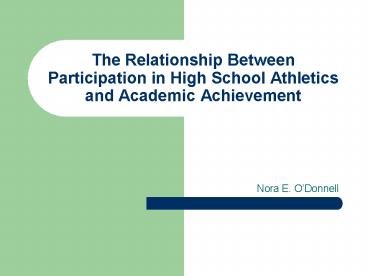The Relationship Between Participation in High School Athletics and Academic Achievement - PowerPoint PPT Presentation
1 / 11
Title:
The Relationship Between Participation in High School Athletics and Academic Achievement
Description:
during First Quarter. grade report date. Athletics and Academics. 6. Data Collected ... The life of the modern-day student athlete: Opportunities won and lost. ... – PowerPoint PPT presentation
Number of Views:90
Avg rating:3.0/5.0
Title: The Relationship Between Participation in High School Athletics and Academic Achievement
1
The Relationship Between Participation in High
School Athletics and Academic Achievement
- Nora E. ODonnell
2
Theoretical Framework
- Studies in the past have examined this very
relationship - Aries, McCarthy, Slovey, and Banaji (2004) found
that all collegiate student-athletes involved
underperformed academically. - Cantor and Prentice (1996) Meyer (1990) and
Parham (1993) determined that time demands of
athletic programs make it difficult for the
athletes to devote necessary study time. - Pascarella et al. (1995) reported that male
football and basketball players read fewer texts
or assigned books than male non-athletes.
3
Participants and Setting
- Members of the 2004 Chaminade-Julienne Varsity
Football Team - Members of the graduating class of 2008
- 12 Sophomore males
- 8 Caucasian
- 4 African American
- Chaminade-Julienne Catholic High School
- Downtown Dayton, Ohio
- 2005-2006 School Year
- Examined grades at 4 different reporting periods
- First Quarter Interim
- First Quarter Report
- Second Quarter Interim
- First Semester Report
4
Data Collection
- Artifact Analysis
- Student report cards
- Quantitative data
- Student Responses
- Survey for student athletes
- Qualitative data
5
Data CollectedArtifact Analysis
- Mean of all 12
- student-athletes
- during first 4 grading
- periods
- Of 12 athletes 9
- increased G.P.A.
- Overall increase of
- 3.04 percent
- Greatest change
- during First Quarter
- grade report date
6
Data CollectedArtifact AnalysisContinued
- Grades of student-
- athletes whose grades
- decreased
- Greatest change during
- First Quarter grade
- report date
- Show signs of
- improvement after first
- reported decrease
7
Data CollectedStudent Responses
- A majority (58.3) of student-athletes reported
they worry about academic eligibility not at
all. - Student-athletes (66.7) reported that they rely
on additional study time to help maintain grade
point average during football season. - When asked about programming that would assist
their academic achievement, 50 responded that
implementing tutoring or weekly progress reports
would help.
8
Interpretation of Findings
- Overall grade point average increased from a C
average to a B average - Additional/Structured study time would assist
student-athletes - Highly volatile time during football season is
the time between First Quarter Interim and First
Quarter grade report date - Period of Adjustment
- Lack of Structured Schedule
- Unexpected high demands athletically and
academically - Majority of players recognize importance
9
Conclusions
- Currently negative reinforcement is the only
motivation for football players to perform
academically - Student-athletes need to balance their time
between academics and athletics - Coaching staff should provide tips
- Teachers should offer auxiliary assistance
- Student-athletes would benefit from mandatory,
structured study time set forth by the Football
coaching staff
10
Anticipated Action
- Convey the plea made by the student-athletes
themselves for additional study time - Implore teachers to offer tutoring before/after
school working with the football teams schedule - Create a spreadsheet of teacher availability
outside of class period - Meet with Football Coaching Staff to determine
the possibility of mandatory study time for these
young men
11
References
- Aries, E., McCarthy, D., Salovey, P., Banaji,
M. R. (2004). A comparison of athletes and
non-athletes at highly selective colleges
Academic performance and personal development.
Research in Higher Education, 45(6), 577-602. - Cantor, N. E., Prentice, D. A. (1996). The life
of the modern-day student athlete Opportunities
won and lost. Paper presented at the Princeton
Conference on Higher Education, Princeton
University, Princeton, NJ. - Meyer, B. B. (1990). From idealism to
actualization The academic performance of female
college athletes. Sociology of Sport Journal,
7(1), 218-227. - Parham, W. D. (1993). The intercollegiate
athlete A 1990s profile. The Counseling
Psychologist, 21(3), 182-194. - Pascarella, E. T., Bohr, L., Nora, A.,
Terenzini, P. T. (1995). Intercollegiate athletic
participation and freshman-year cognitive
outcomes. Journal of Higher Education, 66(4),
24-52.

